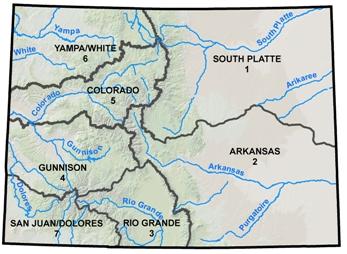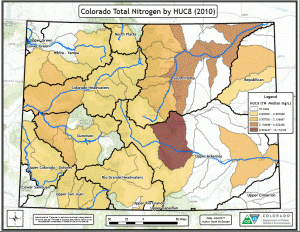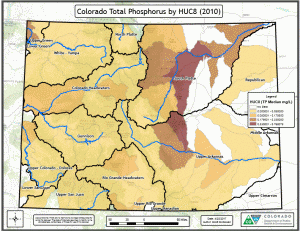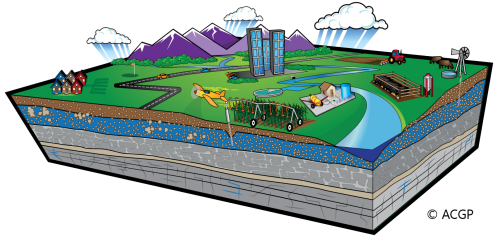Colorado has more than 105,000 river miles and more than 249,000 lake acres. The majority of the state’s rivers originate in the Rocky Mountains and flow downstream through the high desert or high plains regions before leaving the state.

Colorado has seven major river basins:
1. South Platte 5. Colorado
2. Arkansas 6. Yampa/White
3. Rio Grande 7. San Juan/Dolores
4. Gunnison

Nutrients & Water Quality Facts
- The nutrients nitrogen and phosphorus are a natural part of the ecosystem.
- Excess nutrient levels in surface water can cause eutrophication, algal blooms, and fish kills.
- Excess nitrogen in the form of nitrates can contaminate drinking water .
- Nutrient pollution comes from a variety of sources including wastewater, urban stormwater, landscape runoff, and agriculture.
Total Nitrogen in Colorado’s Rivers and Streams
Total Phosphorus in Colorado’s Rivers and Streams
Resources
- Colorado Department of Public Health and Environment: Rivers, Lakes, and Streams
- Regulation 31 Interim Nutrient Standards
- Colorado’s 303(d) List of Impaired Waters
- Colorado Department of Agriculture: Agricultural Chemicals and Groundwater Protection Program
- CSU Extension Water Quality Programs
- Colorado Foundation for Water Education Webinar: “Cyanotoxins, Nutrients, and Public Health”
FAQ
How does Colorado Regulation 85 regulate nutrient pollution?
Regulation 85 follows interim values for total nitrogen, total phosphorus, and chlorophyll a set forth for surface water in Regulation 31.
What is the difference between surface water and groundwater?
Surface water is generally considered to be water on the surface of the earth, such as in rivers, streams, lakes, reservoirs, wetlands, and the ocean.
Surface water can be contrasted with groundwater, which is subsurface water that saturates underground formations and aquifers. However, the two water systems are interrelated.
Regulation 85 regulates Colorado’s surface waters.
What is stormwater?
Stormwater is water that originates from natural precipitation events and from snow/ice melt. Stormwater can be contrasted with applied irrigation water that is humanly controlled and originates from various sources. Both stormwater runoff and irrigation water runoff have the potential to carry nutrients.
What is a “point source” of discharge or pollution?
A “point source” is a single, identifiable source of discharge such as a pipe, drain, ditch, or confined animal feeding operation (CAFO).
What is a “nonpoint source (NPS)” of discharge or pollution?
Nonpoint source (NPS) discharge is diffuse, or distributed over a wide area, and therefore difficult to pinpoint. Examples include agriculture and forestry.
What is nutrient pollution?
Nutrient pollution is a widespread national challenge that is caused by excess nitrogen and phosphorus in the water and air. Nutrients are a natural part of the ecosystem. But a wide range of human activities can cause too much nitrogen and phosphorus to enter the water and air.
What are sources of nutrient pollution?
- Sewage treatment plants
- Landscape fertilizer
- Animal waste
- Agriculture
- Urban stormwater runoff
- Faulty septic systems
Are nitrogen and phosphorus considered toxic?
No. These plant nutrients are a natural part of the ecosystem and are required for plant growth. However, excess levels in water supplies can create environmental and human health problems.

 Larger Map
Larger Map Larger Map
Larger Map